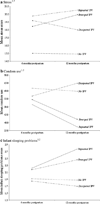Postpartum intimate partner violence and health risks among young mothers in the United States: a prospective study
- PMID: 24562504
- PMCID: PMC4142118
- DOI: 10.1007/s10995-014-1444-9
Postpartum intimate partner violence and health risks among young mothers in the United States: a prospective study
Abstract
The study assessed the relationship between postpartum intimate partner violence (IPV) and postpartum health risks among young mothers over time. Data were collected from 2001 to 2005 on young women aged 14-25 attending obstetrics and gynecology clinics in two US cities. Postpartum IPV (i.e., emotional, physical, sexual) was assessed at 6 and 12 months after childbirth (n = 734). Four types of postpartum IPV patterns were examined: emerged IPV, dissipated IPV, repeated IPV, and no IPV. Emerged IPV occurred at 12 months postpartum, not 6 months postpartum. Dissipated IPV occurred at 6 months postpartum, not 12 months postpartum. Repeated IPV was reported at 6 months and 12 months postpartum. Postpartum health risks studied at both time points were perceived stress, depression, fear of condom negotiation, condom use, infant sleeping problems, and parental stress. Repeated measures analysis of covariance was used. The proportion of young mothers reporting IPV after childbirth increased from 17.9 % at 6 months postpartum to 25.3 % at 12 months postpartum (P < 0.001). Emerged and/or repeated postpartum IPV were associated with increased perceived stress, depression, fear of condom negotiation, and infant sleeping problems as well as decreased condom use (P < 0.05). Dissipated postpartum IPV was associated with decreased depression (P < 0.05). IPV screening and prevention programs for young mothers may reduce health risks observed in this group during the postpartum period.
Figures


References
-
- Kingston D, Heaman M, Fell D, et al. Comparison of adolescent, young adult, and adult women’s maternity experiences and practices. Pediatrics. 2012;129:e1228–e1237. - PubMed
-
- Catalano S. Intimate partner violence in the United States. Washington, DC: U.S. Department of Justice, Bureau of Justice Statistics; 2007. http://www.bjs.gov/content/pub/pdf/ipvus.pdf.
-
- Harrykissoon S, Rickert V, Wiemann C. Prevalence and patterns of intimate partner violence among adolescent mothers during the postpartum period. Archives of Pediatrics and Adolescent Medicine. 2002;156:325. - PubMed
Publication types
MeSH terms
Grants and funding
LinkOut - more resources
Full Text Sources
Other Literature Sources
Medical

